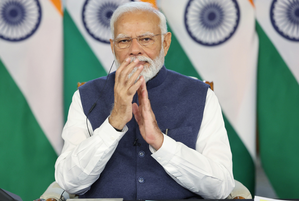New Delhi, Feb 29 (IANS) Growth rate under Congress-led UPA I and UPA II and BJP-led NDA era is a debatable issue, as both parties have gone at great lengths to brag about landmarks and milestones achieved under the respective regimes.
Here is an insightful analysis, based on hardcore data analysis, which compares the growth charts in last 10-15 years, with specific attention to Parliamentary constituencies and also district to sub-district levels and also concludes, which era ‘got the better of whom’ in terms of growth.
Shamika Ravi, a member of Economic Advisory Council to Prime Minister, has taken a deep dive and done a comprehensive analysis by mixing two data sets. Her research titled ‘Politics in Action’ has collated day-time satellite data for built-up area under Parliamentary constituencies and compared it with data sourced from Election Commission, to map the growth under UPA and NDA governments.
BJP-led NDA wins the comparison hands down, as it is found to have nurtured fast-paced growth and spurring economic activity in remote and far-off locations, ‘neglected’ under the UPA 1 and UPA 2.
The day-time satellite imagery data studied growth rates from Parliamentary constituency to sub-district levels and found 18 per cent higher growth rate under Modi government.
The day-time satellite imagery data captured the built-up surface area, under Parliamentary constituencies, at extremely high resolution. The growth of built-areas including roads, building, commercial establishments and other units of infrastructure were studied for drawing conclusions on ‘high growth rate’.
When the average growth was compared across Parliamentary constituencies, it was found to be 3.3 per cent annualised growth in NDA rule (2015-2023) as compared to 2.8 per cent during UPA rule.
On question of ‘which Parliamentary constituency grew the most’, the research found that growth was more widespread under Modi govt as more ‘green spots’ of growth were recorded across the country, North in particular.
It further found that year 2015-2020 saw fastest growth in some of most backward and underdeveloped part of the country.
“Under NDA, highest built up area growth happened in least developed parts of country. Those constituencies, rural and remote in nature, recorded highest annualised growth,’ the research found.
Comparing the growth on district levels, the research found that it was 21 per cent higher under Modi government as compared to UPA 2 while it was 31 per cent higher in comparison to UPA 1.
At the sub-districts level also, 31 per cent greater growth was recorded under NDA, compared to UPA – II while 21 per cent higher growth under NDA was recorded, as compared to UPA- I.
Overall, the study finds that economic activity, under Modi government was more focused on least developed parts of the country, which either lagged behind or remained of least priority, during UPA 1 or UPA 2 rule.
On inequality factor too, the study finds that NDA government was more effective in bringing economic dynamism in backward regions.
Economist Shamika Ravi further said that the day-time data, used for drawing the ‘comparison chart’, is irrefutable as it maps the real-time changes on the ground.
“District and sub-district level data, over last 10 years, was studied to see changes under different regimes, with extremely localised analysis,” she added.
–IANS
mr/uk
Disclaimer
The information contained in this website is for general information purposes only. The information is provided by TodayIndia.news and while we endeavour to keep the information up to date and correct, we make no representations or warranties of any kind, express or implied, about the completeness, accuracy, reliability, suitability or availability with respect to the website or the information, products, services, or related graphics contained on the website for any purpose. Any reliance you place on such information is therefore strictly at your own risk.
In no event will we be liable for any loss or damage including without limitation, indirect or consequential loss or damage, or any loss or damage whatsoever arising from loss of data or profits arising out of, or in connection with, the use of this website.
Through this website you are able to link to other websites which are not under the control of TodayIndia.news We have no control over the nature, content and availability of those sites. The inclusion of any links does not necessarily imply a recommendation or endorse the views expressed within them.
Every effort is made to keep the website up and running smoothly. However, TodayIndia.news takes no responsibility for, and will not be liable for, the website being temporarily unavailable due to technical issues beyond our control.
For any legal details or query please visit original source link given with news or click on Go to Source.
Our translation service aims to offer the most accurate translation possible and we rarely experience any issues with news post. However, as the translation is carried out by third part tool there is a possibility for error to cause the occasional inaccuracy. We therefore require you to accept this disclaimer before confirming any translation news with us.
If you are not willing to accept this disclaimer then we recommend reading news post in its original language.













